Related Research Articles

Naturism is a lifestyle of practicing non-sexual social nudity in private and in public; the word also refers to the cultural movement which advocates and defends that lifestyle. Both may alternatively be called nudism. Though the two terms are broadly interchangeable, nudism emphasizes the practice of nudity, whilst naturism highlights an attitude favoring harmony with nature and respect for the environment, into which that practice is integrated. That said, naturists come from a range of philosophical and cultural backgrounds; there is no single naturist ideology.

The American Association for Nude Recreation (AANR) is a naturist organization based in the United States.
Ed Lange was a nudist photographer, and a publisher of many nudist pamphlets and magazines showing the nudist lifestyle.
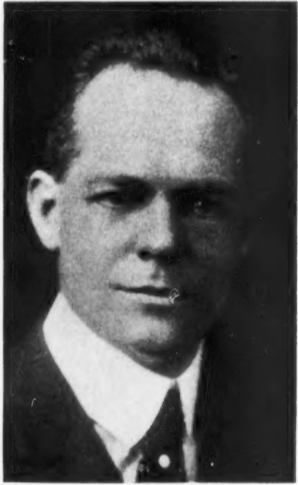
IlsleySilias Boone (1879–1968) was a charismatic speaker, a powerful organizer, a magazine publisher and the founding father of the American Sunbathing Association (ASA)—later reorganized as the American Association for Nude Recreation (AANR). As a publisher he distributed the first nudist magazine in the United States. That publication eventually led to a challenge to the U.S. Postal Service's ban against sending obscene materials through the mail. Boone took his challenge all the way to the U.S. Supreme Court which struck down the ban.
Clothing laws vary considerably around the world. In most countries, there are no laws which prescribe what clothing is required to be worn. However, the community standards of clothing are set indirectly by way of prosecution of those who wear something that is not socially approved. Those people who wear insufficient clothing can be prosecuted in many countries under various offences termed indecent exposure, public indecency, nudity or other descriptions. Generally, these offences do not themselves define what is and what is not acceptable clothing to constitute the offence, and leave it to a judge to determine in each case.

Freikörperkultur (FKK) is a social and health culture that originated in the German Empire; its beginnings were historically part of the Lebensreform social movement in the late 19th century. Freikörperkultur, which translates as free body culture, includes both the health aspects of being naked in light, air and sun and an intention to reform life and society. It is partly identified with the culture of nudity, naturism and nudism in the sense of communal nudity of people and families in leisure time, sport and everyday life.

Christian naturism is the practise of naturism or nudism by Christians.

Social nudity is the practice of nudity in relatively public settings not restricted by gender. This occurs both in public spaces and on commercial property, such as at a naturist resort.
Gay naturism or LGBT naturism concerns a lifestyle of gay people in which nudity, especially in a communal context, is viewed as natural, positive and healthy. While naturist clubs and resorts in the United States date back to the 1930s, gay naturist organizations did not emerge until the early 1980s. Separate from official naturist clubs, gay individuals have long congregated in locally-known gay beaches in many countries, especially in Europe and North America.

Nude recreation consists of recreational activities which some people engage in while nude. Historically, the ancient Olympic Games were nude events. There remain some societies in Africa, Oceania, and South America that continue to engage in everyday public activities—including sports—without clothes, while in most of the world nude activities take place in either private spaces or separate clothing optional areas in public spaces. Occasional events, such as nude bike rides, may occur in public areas where nudity is not otherwise allowed.
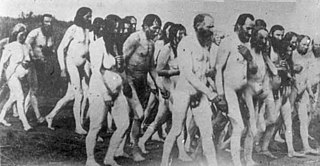
Nudity is sometimes used as a tactic during a protest to attract media and public attention to a cause, and sometimes promotion of public nudity is itself the objective of a nude protest. The practice was first documented in the 1650s with Quakers "naked as a sign" practice. Later the tactic was used by svobodniki in Canada in 1903, and photographs of their nude protests have been published. The tactic has been used by other groups later in the century, especially after the 1960s. Like public nudity in general, the cultural and legal acceptance of nudity as a tactic in protest also varies around the world. Some opponents of any public nudity claim that it is indecent, especially when it can be viewed by children; while others argue that it is a legitimate form of expression covered by the right to free speech.
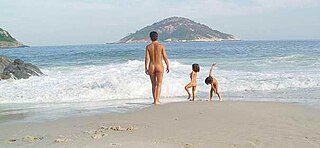
A nude beach, sometimes called a clothing-optional or free beach, is a beach where users are at liberty to be nude. Nude beaches usually have mixed bathing. Such beaches are usually on public lands, and any member of the public is allowed to use the facilities without membership in any movement or subscription to any personal belief. The use of the beach facilities is normally anonymous. Unlike a naturist resort or facility, there is normally no membership or vetting requirement for the use of a nude beach. The use of nude beach facilities is usually casual, not requiring pre-booking. Nude beaches may be official, unofficial, or illegal.
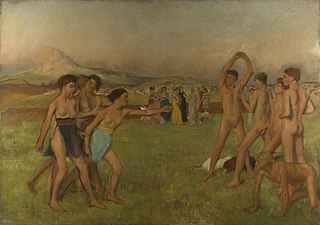
This timeline of social nudity shows the varying degrees of acceptance given to the naked human body by diverse cultures throughout history. The events listed here demonstrate how various societies have shifted between strict and lax clothing standards, how nudity has played a part in social movements and protest, and how the nude human body is accepted in the public sphere.
Felicity Jones is an American naturist who blogs pseudonymously for Young Naturists America. She is from Newton, New Jersey and is known for her activism in the nudism and feminism movements.
Naturism is a cultural and social movement practicing, advocating and defending social nudity in private and in public. It is particularly strong in Germany where it goes under the name Freikörperkultur (FKK). It refers to a lifestyle based on personal, family and/or social nudism in the "great outdoors" environment. Naturism grew out of the German Lebensreform movement and the Wandervogel youth movement of 1896, and has been adopted in many neighbouring European countries and was taken by the German diaspora to North America and other continents.
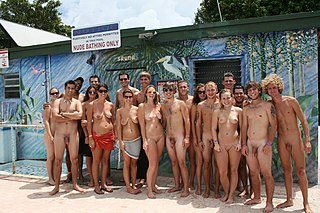
A naturist resort or nudist resort is an establishment that provides accommodation and other amenities for guests in a context where they are invited to practise naturism – that is, a lifestyle of non-sexual social nudity. A smaller, more rustic, or more basic naturist resort may be called a naturist camp.
References
- ↑ Hile, Jennifer (2004-07-21). "The Skinny on Nudism in the U.S." National Geographic. Archived from the original on April 22, 2021. Retrieved 2023-10-02.
- ↑ Jenkins, John; Pigram, John (2004). Encyclopedia of Leisure and Outdoor Recreation. Florence, United States: Taylor & Francis Group. ISBN 978-0-203-64739-4.
- ↑ Hoffman, Brian (2015). Naked: A Cultural History of American Nudism. New York University Press. ISBN 978-0-8147-9053-3.
- ↑ Woodall, Ellen E. (2002). "The American nudist movement: From cooperative to capital, the song remains the same" . Journal of Popular Culture . 36 (2). Wiley-Blackwell: 264–284. doi:10.1111/1540-5931.00006.
- ↑ Harrison, Paul (July 15, 1933). "Nudists Exercise in Secret Gyms Between Outdoor Meets". Miami Daily News. p. 2, col. 1. Retrieved January 1, 2012.
- ↑ Sterbas, James (1974-09-03). "Nudity Increases in America" . The New York Times. p. 23. Retrieved 2023-08-18.
- ↑ Layng, Anthony (1998). "Confronting the Public Nudity Taboo". USA Today Magazine. Vol. 126, no. 2634. p. 24.
- ↑ Woodall, Ellen (2002). "The American Nudist Movement: From Cooperative to Capital, the Song Remains the Same". Journal of Popular Culture. 36 (2): 264–284. doi:10.1111/1540-5931.00006. ISSN 0022-3840 . Retrieved 2019-12-27.
- ↑ "The Naked Truth About Unintended Legislative Consequences". Governing. 2023-08-21. Retrieved 2023-12-27.
- ↑ Attenberry, T.E., ed. (2017). "The Naturist Society, LLC (TNS)". Encyclopedia of Associations: National Organizations of the U.S. (56 ed.). Gale.
- ↑ "2006 Roper Poll". Naturist Education Foundation. Archived from the original on 5 January 2007.
- ↑ "Mark Storey :: Philosophy Department @ Bellevue College". Bellevue College. Retrieved 2023-10-28.
- ↑ Smith, Erika W. (2019-07-13). "How To (Legally) Celebrate National Nude Day". Refinery29 . Retrieved 2023-10-02.
- 1 2 "Clothing Laws by State 2023" . Retrieved 2023-12-27.
- ↑ "Public Indecency Law". Justia. 2018-04-25. Retrieved 2023-12-25.
- ↑ "Hope Springs Eternal". Berkeley Barb. Berkeley, California. March 2, 1969. pp. 1–13. JSTOR community.28033211.
- ↑ Johnson, Art (1969-03-28). "and still it glows". Berkeley Barb. p. 7.
- ↑ "Untitled photo of topfree women at Speedway Meadows". Berkeley Barb. 1969-07-04. p. 11. JSTOR community.28033229.
- ↑ Wollan, Malia (September 26, 2011). "Protesters Bare All Over a Proposed San Francisco Law". The New York Times. Retrieved 15 February 2016.
- ↑ Fowler, Geoffrey (3 October 2012). "Proposed Ban on Public Nudity Offends Some in San Francisco". The Wall Street Journal. Retrieved 18 October 2012.
- ↑ "SF's Most Notorious Nudist Stakes Her Claim to History". SF Weekly. December 2, 2015.
- ↑ Ax, Joseph. "Nudists lose bid to block San Francisco ban on baring all". Reuters. Retrieved 15 February 2016.
- ↑ Wollan, Malia (November 20, 2012). "San Francisco Officials Vote to Ban Public Nudity". The New York Times.
- ↑ "4 arrested for defying San Francisco's nudity ban". www.cbsnews.com.
- ↑ "Police Code - Prohibiting Public Nudity" (PDF). November 20, 2012. Retrieved August 10, 2016.
- ↑ Michelle Robertson (23 February 2017). "Where to get naked in the Bay Area – and not feel weird about it". SFGate.
- ↑ Toolis, Brittany (November 21, 2023). "Why? That's what residents are wondering as City of Seattle plans for playground next to nude beach". KIRO 7. Retrieved November 26, 2023.
- ↑ Beekman, Daniel (2023-12-12). "Concerns swirl before meeting on Seattle's playground plan for nude beach". The Seattle Times. Retrieved 2023-12-23.
- ↑ Boiko-Weyrauch, Anna (2018-09-18). "It's totally legal to be naked in public in Seattle". KUOW/NPR Network. Retrieved 2023-12-27.
- ↑ Hale, Jamie (29 June 2015). "Public nudity in Oregon: Where you can and can't legally be naked in the open". The Oregonian.
- ↑ "Haulover Beach, Florida – America's Best Clothing-Optional Beach" . Retrieved 2023-12-27.
- ↑ Daney, Charles (2022-10-17). "How serious has U.S. naturism's decline been in the past several decades?". Revitalizing Naturism. Retrieved 2024-04-25.
- ↑ Glazer, Reena N. (1993). "Women's Body Image and the Law". Duke Law Journal. 43 (1): 113–147. doi:10.2307/1372748. ISSN 0012-7086. JSTOR 1372748. S2CID 53358345 . Retrieved 2019-11-15.